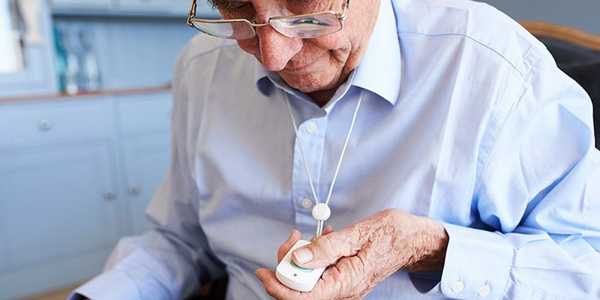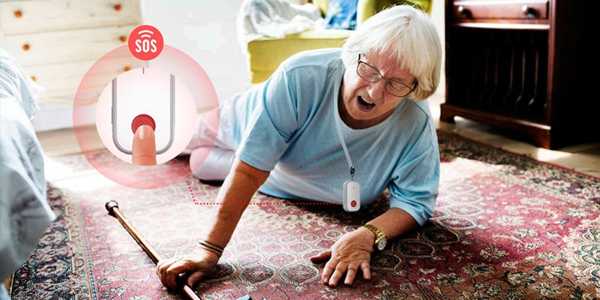Worried about a loved one living alone? Panic buttons save lives! A panic button offers seniors a simple, reliable way to call for help in emergencies like falls or sudden health issues. It’s a small device that brings big peace of mind to both seniors and their families.
Benefits of Panic Buttons
Panic buttons are instrumental in ensuring the safety and independence of the elderly.
Immediate Assistance: Quickly connects users with emergency services or caregivers for prompt help.
Fall Detection: Automatically detects falls and sends alerts, ensuring assistance even if the user cannot press the button.
Enhanced Independence: Reduces reliance on others, allowing seniors to live alone with confidence.
Increased Security: Provides reassurance that help is always within reach, reducing anxiety about emergencies.
Peace of Mind for Caregivers: Ensures loved ones can get timely help, easing family members' concerns.
Improved Quality of Life: Combines safety and convenience, enhancing well-being for both seniors and caregivers.

How Panic Buttons Work
Panic buttons are life-saving devices that utilize Internet of Things (IoT) sensors and systems for effective communication during emergencies. Users, particularly the elderly, can trigger an SOS alert simply by pressing a button. Upon activation, the panic button transmits distress signals through various communication methods, each with distinct benefits.
- Bluetooth: Ideal for short-range communication, it connects devices within close proximity, making it especially useful in home settings where the user is near a caregiver or monitoring device.
- GPS: This technology enables precise location tracking, crucial for emergency responders to quickly locate individuals who may be outdoors or in unfamiliar places.
- LoRaWAN: Long Range Wide Area Network (LoRaWAN) provides expansive coverage, allowing devices to connect over greater distances, making it a perfect choice for rural or larger environments.
Types of Panic Buttons
Here are five notable devices available in the market, showcasing their unique features and technological advancements:
SureSafeGO
- Usability: Lightweight and designed for comfortable wear as a pendant or wristband.
- Features: Equipped with GPS location tracking and an SOS button that connects directly to emergency services.
- Technological Advancements: Utilizes a robust mobile network to ensure assistance is always accessible, even outside the home.
FallSafe
- Usability: Automatically detects falls and alerts caregivers without requiring input from the user, enabling a seamless safety net.
- Features: Integrated with wearables for unobtrusive use.
- Technological Advancements: Incorporates advanced algorithms to differentiate between normal movement and falls.
Fall Alert
- Usability: Tailored for seniors, featuring an easy-to-use alert system activated with a simple button press.
- Features: Includes a voice feature for real-time communication with responders.
- Technological Advancements: Provides guided instructions to seniors during emergency situations, offering crucial reassurance.
SureSafe 24/7 Connect
- Usability: A comprehensive monitoring system providing round-the-clock coverage.
- Features: Offers mobile and in-home alert options for various situations.
- Technological Advancements: Includes a two-way communication system for immediate assistance and interaction.
MOKOSMART
- Usability: A versatile device functioning as both a panic button and a daily health tracker.
- Features: Monitors health metrics while providing emergency alerts at the touch of a button.
- Technological Advancements: Merges health monitoring with safety features for holistic care delivery.
These devices combine user-friendliness with innovative technology, ensuring elderly users receive prompt assistance whenever they need it, enhancing their independence and security.
Key Features to Consider
When selecting a panic button, several key features should stand out to guarantee efficacy and safety for elderly users:
Reliable Fall Detection: Essential for automatically notifying caregivers or emergency services during a fall, thus minimizing response times for injuries, which are common among seniors.
GPS Tracking: Real-time location monitoring is vital for ensuring prompt assistance, particularly for individuals with dementia or who may wander.
Waterproof Designs: Accidental spills or showers shouldn’t impair functionality. Waterproof panic buttons ensure durability and reliability in all conditions.
Battery Life: Extended battery life is critical to maintain functionality, preventing risks associated with a device losing power during emergencies.
Integration Options: The ability to connect with smart home systems can enhance convenience, allowing notifications to be shared across devices seamlessly.

Applications of Panic Buttons Across Various Settings
Panic buttons play a pivotal role across different environments, providing rapid responses to emergencies. At home, for instance, an elderly individual can utilize the panic button to alert family members or emergency services in case of a fall or health crisis, ensuring timely aid that can mitigate serious injuries.
In healthcare facilities like hospitals, panic buttons enhance patient safety by facilitating quick access to assistance for vulnerable patients who may need immediate support, providing peace of mind for those who have mobility challenges.
Outdoors, panic buttons are especially vital for seniors enjoying hikes or outdoor activities where accidents can occur or where they might face health emergencies. By pressing the button, help can arrive swiftly, significantly improving safety.
Choosing the Right Panic Button
Selecting the most appropriate panic button for seniors involves assessing several critical factors. Start with comparative model evaluations based on features such as battery life, range, and portability. Review the monitoring systems offered, favoring options that provide 24/7 support or can integrate with existing health systems. Most importantly, consider the specific needs of the individual—elements such as mobility, living arrangements, and health conditions can greatly influence the best choice. A thoughtful selection process will empower families to choose a panic button that promotes safety and independence for their loved ones, contributing to peace of mind for all involved.
